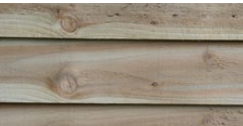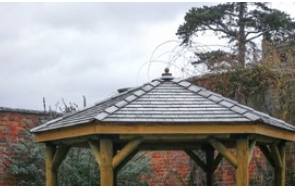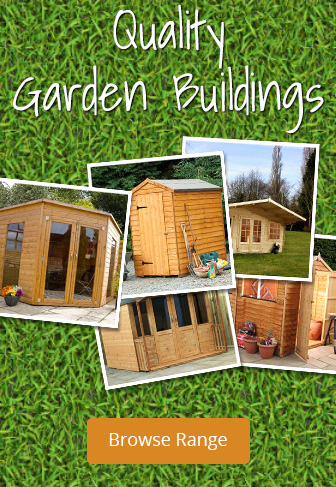The Properties of Timber
Our manufacturers put a lot of care and attention into the manufacture of their products as they, as well as we, want you to enjoy them for many years to come.
To help you get the most out of their products, it is useful to know a little more about the properties of timber, what is normal and how your product may behave as the seasons change. And that is where this guide created by the experts at Hartwood comes in. Let us dive in...

Wood is an extremely durable material for construction but as a natural product when used outdoors it is susceptible to changes in the environment. Depending on the type of product you have and the style of construction, extreme weather conditions may cause reactions in the timber.
Timber is also subject to natural imperfections depending on the growth of the tree. We only use the highest quality timber and all of our products pass high levels of quality checks before leaving our site, small imperfections and natural variations won’t affect the structural integrity of your product.
Things that you may see in your product:
Movement, Twisting and Warping: Wood contains a natural level of moisture so increasing humidity levels in the surrounding air may cause panels to change their shape as the porous fibres shrink. This can be exaggerated during prolonged periods of dry weather. Similarly, in the winter months the opposite may occur with the wood swelling.
Movement and gaps in timber products are normal – you will see more movement with overlap constructions as the cladding has more room to move. Shiplap and Tongue & Groove constructions are more stable as the panels are interlocking but in hot weather you may still see some shrinkage. In most cases of warping, the wood will revert to its original form once the high temperatures subside and there is more moisture content in the air.
Expansion, Contraction, Splits and Cracks: All timber will expand and contract according to its environment. As a result of this expansion and contraction it is very common to see splits and cracks developing in the wood - including posts and uprights.
Splits are common during the Spring and Summer months as the wood begins to dry out. The outer surface dries first and contracts, contracting over a still expanded core of the wood. The result of this is that splits and cracks appear along the grain of the wood. These splits are not a fault and do not affect the structural integrity of a product. They are simply a part of the how timber product responds to their environment and will usually close over time. When assembling your product please make sure you pre-drill as this will lessen the potential for splits.

Timber Variation: It is completely natural to see some knots within timber; a knot is formed where a branch attached to a trunk. These are not a cause for concern and do not affect the quality of the product.
Mould: Mould is a surface-dwelling fungi that feeds on nutrients and debris contained in the surface cells of timber. The most common problems associated with mould are discolouration of the timber, and an increase in permeability of the timber. Mould does not cause the timber to rot.

The application of a good quality preservative that contains a mildewcide is the best preventative measure for mould. If a mould infestation has taken hold then a proprietary brand of mould remover, which again contains mildewcide will be effective in removing the mould.
Blue Stain: Blue stain is part of the same family as moulds but penetrates deeper into the surface layers of the timber. It stains the timber a dark blue colour, whereas mould is usually black. The best way to differentiate between the two is to rub your finger over the affected area. Mould will be visible on your finger whereas Blue Stain won’t due to its penetration of the deeper surface layers. Preventative and remedial measures are the same as the measures used for mould.
Wood Colouration

Pressure Treated wood colouration varies depending on timber species and length of time from treatment, the colour will fade over time to an attractive silver/brown. You may have some Pressure Treatment residue, in the form of green spotting or marks. These are normal and do not affect the quality of the product.

Dip Treated product colour is not permanent and to retain factory finish treatment should be applied regularly.

Cedar shingles used on the roof of the Hartwood Round Timber Gazebos and Hartwood Retreat Sheds will fade over time to a slivery, grey colour.
Timber Treatment

Hartwood products are guaranteed against rot through either Pressure Treatment or Dip Treatment.
Pressure Treated Timber

Hartwood Pressure Treated items which are designed to be in ground contact are impregnated with preservative, an effective method used to protect wood against fungal decay and insect attack, saving time and money on retreating. The treatment is based on the well-established effectiveness of copper combined with a co-biocide.
If the treated timber is cut, notched or drilled it is recommended that an effective cut end treatment be applied, failure to do so may reduce effectiveness of the Pressure Treatment.
Stains, paint and water repellent may be applied after purchase providing you follow the manufacturer’s instructions.

Dip Treated Timber
Dipped Treated products should be isolated from the ground with a Pressure Treated gravel board or similar base and be retreated periodically to comply with the conditions of the guarantee.
To change the colour of the timber, allow the product to settle before applying a suitable brand of stain/paint.
Ongoing Care
We recommend some annual after care which will help protect the wood and make it more durable to ensure it lasts longer. Preservatives, also known as wood treatment, can protect all types of timber from discolouration and decay, as well as giving a constant all-year-round colour. An annual wood preservative paint will protect your new purchase or rejuvenate an existing one.
In addition to the annual application of a preservative we also recommend the annual application of a wax or oil based weatherproofing finish. This will stabilise the movement of your product caused by atmospheric moisture levels, and protect it from the elements.

Keeping your timber building ventilated is important as moisture can become trapped between layers of non-breathable materials and build-up, leading to floors becoming rotten.
Regular housekeeping is also recommended to prolong the life of your product. Ensure debris is not allowed to build up on the roof as this will hold moisture which can lead to the premature wear of any roof covering, cause the product to leak, and ultimately cause the product to rot. Prune back any vegetation that comes into contact with the product as this can also act as a conduit for moisture.
Log Cabins
The logs used in Hartwood range of cabins are manufactured from kiln dried timber, a process which extracts moisture to an exact level. This method minimises the risk of splitting and reduces warping to an absolute minimum. Pressure treated floor bearers are supplied with each cabin, but the rest of the structure is supplied in its raw timber form and is untreated. A good quality treatment should be applied to both the inside and outside of a cabin within a maximum of three weeks of assembly. As the UK has a very wet climate it is important to ensure that the timbers remain dry and protected until such time as a treatment is applied. Please see further information in the Hartwood Log Cabin Aftercare Guide.



